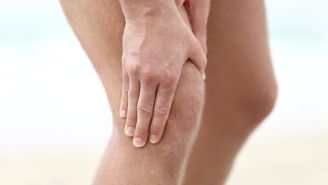If you have osteoarthritis of the knee, you have company. Estimates vary, but osteoarthritis affects as many as 32 million adults in the United States and is one of the leading causes of disability in older adults. Roughly one-half of adults will experience symptoms of knee osteoarthritis at some point in their lives.
But you can take charge of your joint health by learning all you can about the condition. Here are a few key questions to ask your healthcare provider (HCP):
How do you know it’s osteoarthritis and not something else?
Osteoarthritis is a significant cause of knee pain. But other inflammatory conditions and injuries can also cause pain, as can other types of arthritis (of which there are more than 100). Treatment varies depending on the cause, so getting an accurate diagnosis is essential.
Your HCP will conduct a full evaluation of your symptoms and health history and will determine the range of motion in your knee joint. They may also order an X-ray, ultrasound, or MRI (magnetic resonance imaging) scan to look inside the joint. Your HCP may also draw fluid from the joint to see if it shows signs of deterioration.
You may receive a diagnosis from your HCP, or they may refer you to a rheumatologist, a specialist in diseases such as arthritis.
What causes osteoarthritis?
When you have osteoarthritis, joint cartilage between bones becomes damaged or breaks down. But it’s more than just wear and tear on the joint. It’s a complex disease with multiple risk factors. One of these is age.
The older you are, the more likely you are to develop osteoarthritis. About 80 percent of people over age 55 will show signs of osteoarthritis when diagnosed with X-rays, but not all will have pain.
Being obese and experiencing a traumatic knee injury are two of the other most significant risk factors. The increasing incidence of obesity, especially in people 40 to 60 years old, is believed to be driving the increase in knee osteoarthritis. The higher your body mass index (BMI), the more likely you are to develop osteoarthritis.
Genetics also plays a role. It is believed that at least 30 percent of your risk for osteoarthritis is determined by your genes.
Can my osteoarthritis be cured?
Unfortunately, no. Joint damage from osteoarthritis cannot be reversed. Osteoarthritis is a progressive disease, although the rate of progression varies from person to person.
The best treatment plan for knee osteoarthritis consists of managing pain and symptoms and slowing the progression of the disease. Most patients with knee osteoarthritis employ a combination of medications and non-pharmaceutical treatments, including exercise, physical therapy and weight loss.
Will I need surgery?
It depends. According to the Agency for Healthcare Research and Quality, more than 790,000 knee replacement surgeries are done in the United States each year. The procedure can help patients who have severe knee osteoarthritis that limits their day-to-day activity and whose symptoms persist despite other therapies. More than 90 percent of those patients who undergo knee replacement surgery find it relieves pain and allows them to be active again. Ask your HCP if you are a candidate.
Note that surgical procedures other than a knee replacement may also be helpful. These include:
- Arthroscopic debridement: Surgeons make small incisions in your knee and insert thin instruments to remove loose particles of bone and cartilage from the joint.
- Osteotomy: Surgeons reshape or reposition the shinbone or thighbone to relieve pressure on the knee joint.
- Cartilage grafting: This procedure takes healthy tissue from another part of the knee or from a tissue bank to fill holes in the knee cartilage. It’s usually for younger patients with small areas of cartilage damage.
Talk to your HCP about the best option for your situation.
What can I do to manage my symptoms?
The two most important things you can do are lose weight and move your body. Carrying extra weight puts a lot of pressure on the knee joint and losing even a small amount of weight can make a big difference. In fact, according to the Arthritis Foundation, losing one pound of body weight will take four pounds of pressure off your knee.
Exercise, including aerobic and strengthening exercises, is a critical component of any osteoarthritis management program. Walking, water exercises, and tai chi are all good low-impact options. Your HCP or a qualified physical education professional can help you develop a safe and effective exercise program.







